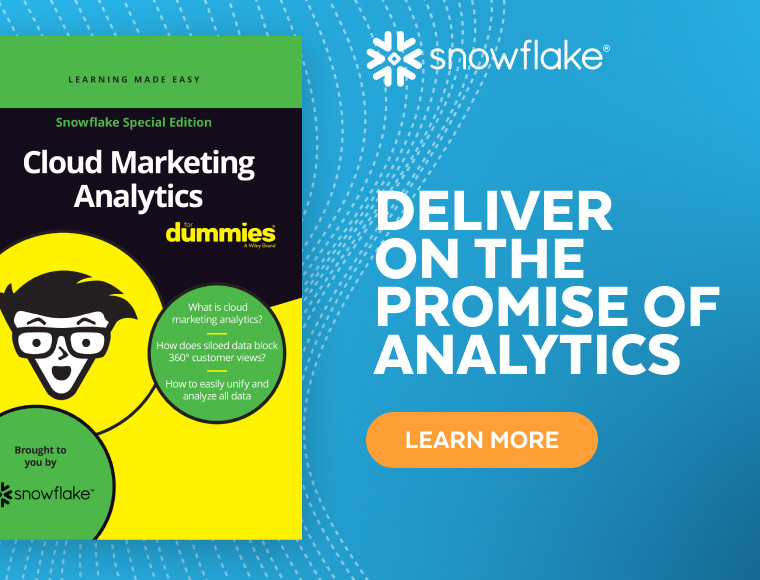Predictive Analytics in Marketing
Predictive analytics helps marketers make better decisions today by providing insights into what’s likely to happen in the future. But many factors go into the creation of a trend, and recognizing patterns in data can be difficult given the exponential growth of data being generated from different devices and channels. Predictive analytics empowers marketers to make important connections in their data to improve decision-making and planning.
What Is Predictive Analytics, and What Role Does It Play in Marketing?
Predicting the future with 100% accuracy remains out of reach no matter how much data you’ve collected and analyzed. But marketers can forecast probable outcomes with a high degree of precision using predictive analytics methods. With predictive data modeling, data gathered from in-house and third-party data sources is analyzed to uncover patterns, outliers, and other key indicators to identify likely outcomes in various scenarios.
With these insights, marketing teams optimize their campaigns to meet behavior, event-based, or revenue goals. Artificial intelligence, machine learning, and historical data combine to create the kinds of data-driven insights marketers need to attract, retain, and nurture customers.
How Can Predictive Analytics Aid in Creating Successful Marketing Campaigns?
Big data is the fuel powering modern marketing. Predictive analytics plays an important role in converting this data into actionable insights that improve the quality of segmentation, targeting, and promotion efforts. Here are a few ways marketers are using predictive analytics to improve their effectiveness.
Accurately predict consumer trends
Consumer preferences are in a constant state of flux. Predictive analytics analyzes data from many sources, including contextual data such as weather and location, consumer sentiment, and online content like web pages and social media posts. Spotting an emerging trend quickly gives marketers a distinct advantage.
Refine customer segmentation
Machine learning can help marketers improve the quality of their clustering decisions by spotting subtle relationships between data from individual customers. With this information, marketers can slice and dice customer segmentation in different ways to improve targeting and, ultimately, deliver personalized campaigns to customers and prospects.
Create highly customized campaigns
Delivering the right message to the right customer at the right time requires customization. Predictive analytics helps marketers better understand the behavior of individuals and more accurately predict which messages are most likely to resonate with which customers, which platforms are best for effectively reaching customers, and when to launch campaigns or send offers.
Reduce customer churn
Attracting new customers is more expensive than retaining existing ones. Predictive analytics can spot trends in customer disengagement, providing marketers with an opportunity to shore up areas of weakness such as a subpar customer service experience or a poorly performing product line. By analyzing patterns in data, these tools can also identify those customers most likely to disengage and ultimately churn. Once identified, these high-risk customers can be placed into a re-engagement program that provides personalized experiences designed to reduce attrition.
Prepare for a post-cookie future
As the clock winds down on third-party cookies, predictive analytics and other related technologies, such as artificial intelligence (AI), will play an increasingly important role in personalizing marketing efforts. In-depth analysis of both first- and third-party data sets will become even more crucial to gain predictive insights on customer behavior, customer lifetime value, and more.
Deploying Predictive Analytics to Solve Marketing Problems
Predictive analytics is being used to resolve some of the marketing industry’s most pressing challenges. Here are just a few.
Improving marketing resource allocation
Predictive analytics tools enable marketing teams to use their resources more efficiently while increasing ROI. By accurately predicting customer behavior and segmenting for personalization, marketers can create highly effective marketing campaigns targeted only to those most likely to take the desired action—and avoid marketing spend on those unlikely to convert. Missteps are difficult and costly to correct mid-campaign, so getting all the elements of a campaign dialed in at the outset allows marketing teams to avoid wasting resources.
Recommendation engines
Recommendation engines are designed to maximize the value of each customer and are used at various stages in the buying journey to suggest products highly likely to appeal to the individual. This strategy can increase the average value of an order significantly. Effective recommendations are based on a shopper’s purchase history data, lifestyle data, and other information to recommend only those products that closely align with their interests. Predictive analytics is used to combine relevant data and identify products that meet the criteria at hand.
Retaining customers
Providing a seamless, engaging omnichannel experience is essential to retaining existing customers. Today consumers interact with brands across multiple touchpoints including mobile apps, ecommerce websites, social media, and in-store visits. Predictive analytics connects the data generated from each customer interaction, helping marketers provide valuable promotions and special offers to their customers across the entire ecosystem.
Predictive Analytics Powered by the Snowflake Data Cloud
Snowflake enables marketers to supercharge their marketing campaigns with predictive analytics. With the Snowflake Data Cloud, you can bring all your data together in a highly secure platform that makes governance and compliance simple. Powerful capabilities allow you to build predictive models with speed. In addition, our partner ecosystem provides a wide range of tools and platforms to expand data analytics capabilities in the cloud. And you can enrich in-house data with third-party datasets from the Snowflake Marketplace.
